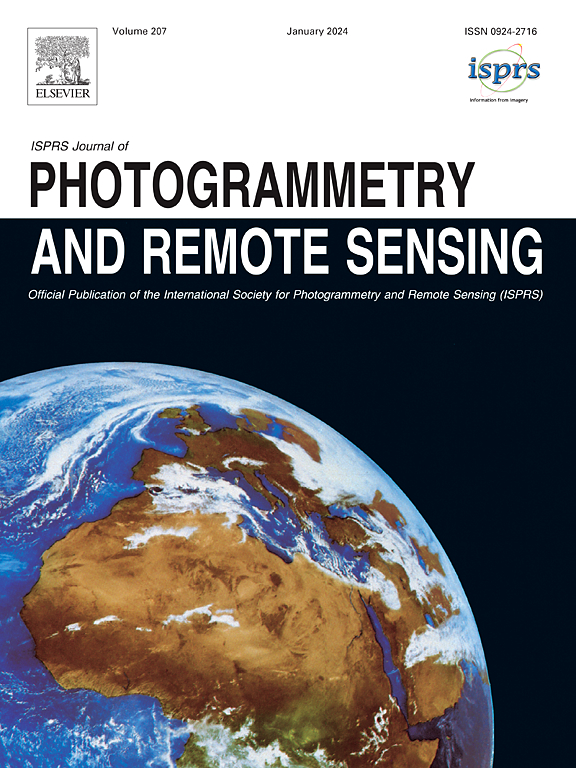HDRSA-Net: Hybrid dynamic residual self-attention network for SAR-assisted optical image cloud and shadow removal
IF 10.6
1区 地球科学
Q1 GEOGRAPHY, PHYSICAL
ISPRS Journal of Photogrammetry and Remote Sensing
Pub Date : 2024-11-07
DOI:10.1016/j.isprsjprs.2024.10.026
引用次数: 0
Abstract
Clouds and shadows often contaminate optical remote sensing images, resulting in missing information. Consequently, continuous spatiotemporal monitoring of the Earth’s surface requires the efficient removal of clouds and shadows. Unlike optical satellites, synthetic aperture radar (SAR) has active imaging capabilities in all weather conditions, supplying valuable supplementary information for reconstructing missing regions. Nevertheless, the reconstruction of high-fidelity cloud-free images based on SAR-optical data fusion remains challenging due to differences in imaging mechanisms and the considerable contamination from speckle noise inherent in SAR imagery. To solve the aforementioned challenges, this paper presents a novel hybrid dynamic residual self-attention network (HDRSA-Net), aiming to fully exploit the potential of SAR images in reconstructing missing regions. The proposed HDRSA-Net comprises multiple dynamic interaction residual (DIR) groups organized into an end-to-end trainable deep hierarchical stacked architecture. Specifically, the omni-dimensional dynamic local exploration (ODDLE) module and the sparse global context aggregation (SGCA) module are used to form a local–global feature adaptive extraction and implicit enhancement. A multi-task cooperative optimization loss function is designed to ensure that the results exhibit high spectral fidelity and coherent spatial structures. Additionally, this paper releases a large dataset that can comprehensively evaluate the reconstruction quality under different cloud coverages and various types of ground cover, providing a solid foundation for restoring satisfactory sensory effects and reliable semantic application value. In comparison to the current representative algorithms, the presented approach exhibits effectiveness and advancement in reconstructing missing regions with stability. The project is accessible at: https://github.com/RSIIPAC/LuojiaSET-OSFCR.
HDRSA-Net:用于合成孔径雷达辅助光学图像云和阴影去除的混合动态残差自注意网络
云层和阴影经常会污染光学遥感图像,导致信息缺失。因此,对地球表面进行连续时空监测需要有效地去除云层和阴影。与光学卫星不同,合成孔径雷达(SAR)在任何天气条件下都能主动成像,为重建缺失区域提供宝贵的补充信息。然而,由于成像机制的差异以及合成孔径雷达图像固有的斑点噪声的严重污染,基于合成孔径雷达-光学数据融合重建高保真无云图像仍然具有挑战性。为解决上述难题,本文提出了一种新型混合动态残差自注意网络(HDRSA-Net),旨在充分挖掘合成孔径雷达图像在重建缺失区域方面的潜力。所提出的 HDRSA-Net 由多个动态交互残差(DIR)组组成,形成一个端到端可训练的深度分层堆叠架构。具体来说,全维动态局部探索(ODDLE)模块和稀疏全局上下文聚合(SGCA)模块用于形成局部-全局特征自适应提取和隐式增强。本文设计了一个多任务合作优化损失函数,以确保结果具有高频谱保真度和连贯的空间结构。此外,本文还发布了一个大型数据集,可以全面评估不同云层覆盖和各类地表覆盖下的重建质量,为还原令人满意的感官效果和可靠的语义应用价值奠定了坚实的基础。与目前具有代表性的算法相比,本文提出的方法在稳定重建缺失区域方面表现出了有效性和先进性。该项目可通过以下网址访问:https://github.com/RSIIPAC/LuojiaSET-OSFCR.
本文章由计算机程序翻译,如有差异,请以英文原文为准。
求助全文
约1分钟内获得全文
求助全文
来源期刊

ISPRS Journal of Photogrammetry and Remote Sensing
工程技术-成像科学与照相技术
CiteScore
21.00
自引率
6.30%
发文量
273
审稿时长
40 days
期刊介绍:
The ISPRS Journal of Photogrammetry and Remote Sensing (P&RS) serves as the official journal of the International Society for Photogrammetry and Remote Sensing (ISPRS). It acts as a platform for scientists and professionals worldwide who are involved in various disciplines that utilize photogrammetry, remote sensing, spatial information systems, computer vision, and related fields. The journal aims to facilitate communication and dissemination of advancements in these disciplines, while also acting as a comprehensive source of reference and archive.
P&RS endeavors to publish high-quality, peer-reviewed research papers that are preferably original and have not been published before. These papers can cover scientific/research, technological development, or application/practical aspects. Additionally, the journal welcomes papers that are based on presentations from ISPRS meetings, as long as they are considered significant contributions to the aforementioned fields.
In particular, P&RS encourages the submission of papers that are of broad scientific interest, showcase innovative applications (especially in emerging fields), have an interdisciplinary focus, discuss topics that have received limited attention in P&RS or related journals, or explore new directions in scientific or professional realms. It is preferred that theoretical papers include practical applications, while papers focusing on systems and applications should include a theoretical background.
 求助内容:
求助内容: 应助结果提醒方式:
应助结果提醒方式:


